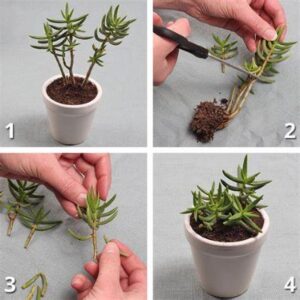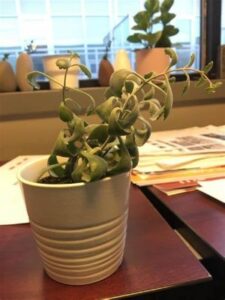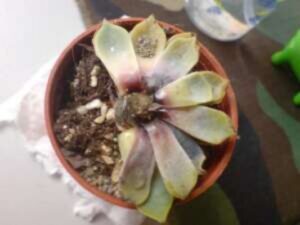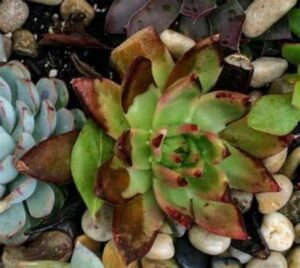Table of Contents

When a succulent dies, you might think it’s dead, but there’s still hope. You can revive a dead succulent by propagating it; you’ll have two plants instead of one!
Before you start, make sure your plant is dead. If the leaves are still green and fresh looking, wait a few more days before reading this article. If they’re brown and crispy, then read on!
Visit our guide to learn how to revive a succulent, including the beloved aloe plant, with our comprehensive guide on how to revive an aloe plant.
Revive Succulent Plant – Step-By-Step Guide
Succulents aren’t the hardiest of plants, but they can be resilient if you take good care of them. If you have a succulent that has started to wither or die, you can revive it by following these steps:
- Remove all dirt from around the plant and rinse it with water until all the dirt is removed.
- Cut off the dead parts of your succulent and trim back any dead leaves with sharp pruning shears or scissors.
- Trim away any dead roots with a small pair of scissors by cutting at least an inch away from the base of the plant. You don’t want to remove any more than necessary, so don’t cut too deep into healthy tissue when doing this step!
- Use a sharp knife or razor blade to scrape away any remaining dead tissue at the base of your plant where it meets its container (if applicable). This will allow air circulation to reach all parts of your plant so that it can start healing itself faster!
- Place your newly trimmed succulent in indirect sunlight for several hours each day until it shows signs of new growth (usually within 2-3 weeks). Do not place it directly in direct sunlight or near heat sources; this could damage or burn its leaves.
- If you live in a humid climate (such as Florida), mist your succulents daily with room-temperature water until they begin sprouting new growth from their tips (usually within one week).

How To Trim Succulents? – Step-By-Step Guide
Succulents are very easy to propagate and grow. They can store water in their leaves, stems, and roots, making them more drought-resistant. They can be propagated by dividing the plant into small pieces, sowing seeds, or cuttings.
The most common way of propagating is by taking cuttings from your succulent plants. This is an easy process and doesn’t require much time or effort. You can even do it while watching TV or doing other chores around the house.

Here’s how:
First, find a healthy succulent with roots growing out of its pot that hasn’t flowered yet (or if it has flowered already, wait until its flowers dry up).
Next, remove any soil that may still be clinging to the root ball and gently remove any dead leaves on the stem with your fingers or a pair of tweezers. Finally, cut off about 4–6 inches (10–15 cm) from the top of your plant using a sharp knife or scissors; leave at least one leaf intact from where you’ve made your cut to continue photosynthesizing sunlight for its new offspring!
Learn how to save your succulents after a frost by following our helpful guide on how to save plants after a frost.
Symptoms of Dying Succulent
These are the main symptoms of a dying succulent:
- One of the main symptoms of dying succulent is total wilting and death. As the plant dries out, its leaves turn yellow and brown. We also notice it has stopped breathing, with weeds or leaves falling off. Sometimes it happens with your grass as it turns yellow; in this situation, you must take good care of your green babies.
- Symptoms of dying succulents are the same as symptoms of succulent plants, including dehydration and adjustment to your new life after death.
- Many succulents are easy to grow and care for. They can be raised without fail. They can be grown without proper watering, care, and repotting. However, if your succulent shows symptoms of dying, it could signify one or more damage.
- The main symptoms of dying succulents are yellowing leaves, falling leaves, and die-off sections. If you notice these symptoms, there is something that you can do to help.
- First, not all succulents are affected by dying in one way or another. However, removing faded or yellowing leaves whenever possible is best because they tend to appear more quickly than green leaves that remain on plants. If one plant becomes yellowed and its stem begins to drop off, it could take several months for its colors to return or for new growth to come from the root.
How to Revive Succulents Planted Indoor?

Succulents are a great plant to have indoors, but they can sometimes get too thirsty. If your succulent is looking a little limp, here’s how you can revive it:
- Let the soil dry out completely before watering again.
- Water it less often than usual until new growth appears.
- Report it if it needs more space or if roots are coming out of the bottom of the pot (it will tell you when it does).
- If the leaves turn yellow, cut them off with scissors or pliers.
Explore our guide on reviving a bamboo plant for green thumb tips and tricks.
Reasons For Dying Succulent

There are many reasons why your succulent may be dying. The most common reason is overwatering, especially in winter when the soil dries out quickly and needs more water than usual to stay hydrated.
Other reasons for dying succulents include:
Not enough light
Succulents need bright light but not direct sunlight to thrive. If they don’t get enough light, they will become leggy, which means they’ll grow upward instead of outward and have fewer flowers or leaves than they would if they had more light available. Some varieties of cacti may also start turning yellow or brown if they don’t get enough light.
Not Enough Water
If a succulent had not had enough water, it could have lost its leaves or turned brown and died. If you neglect your plant, it will tell you so by turning brown and dying.
Overwatering
Overwatering is another common problem with succulents. If you give them too much water, they will rot and die. Overwatering can also cause root rot, which will kill the entire plant. Be sure to let them dry out between watering sessions if they are indoors. If they live in a pot that drains well, this should not be a problem.
You Overfeed Succulent Plant
Overfeeding a succulent plant can lead to various problems. The roots may become waterlogged, causing root rot and depriving the plant of oxygen. This can result in wilting, yellowing, drooping leaves, and ultimately, the plant’s death. Overfeeding can also lead to nutrient imbalances, causing stunted growth or discolored leaves. Moreover, excessive fertilization can increase the concentration of salts in the soil, leading to burning of the plant’s roots. Following a proper watering and fertilizing schedule is essential to prevent overfeeding, ensuring the plant’s health and longevity. Remember, succulents thrive in well-draining soil and prefer infrequent, deep watering rather than constant moisture.

What To Do If Succulent Turning Yellow-Brown and Black?


It likely has gone wrong if the succulent is browning or blackening at the base. You can try these steps to revive it:
- Cut off the plant’s roots and discard them.
- Fill a pot or sink with water and place the plant in it.
- Bring the water to a gentle boil, turn off the heat, and let the plant soak for 30 minutes.
- Remove the plant from the water and place it in an airtight container. The succulent may be experiencing brown rot or black rot. Water it well and feed it a diluted liquid fertilizer to revive the succulent. You can also try a fungicide if the decay is severe.
Learn more about the appearance of ginger plants in our article: what does a ginger plant look like?
Tips To Grow Succulents
If your succulent has started to wilt, you can revive it by following a few simple steps. Here’s how:
Move Your Succulent To A Sunnier Spot
The first thing you’ll want to do when trying to revive your dying succulent is moved it out of the shade and into direct sunlight. Succulents need at least six hours of sunlight each day, or they will not thrive properly. If you don’t have a spot in your yard that gets at least six hours of direct sunlight daily, consider placing it on an east-facing window sill inside the house instead. This will allow it to receive morning sunlight during the summer and winter sunlight during the winter months when the sun rises later in the morning than usual due to shorter days and nights.
Give Your Succulent A Dose Of Water
Next up on our list of things to do when reviving your dying succulent is giving it some water! This step is super important because it will die if you don’t give your succulent water.
The best way to revive a dying succulent is by giving it water. This step is so important that we’ve covered it in our guide on caring for succulents.
Give Your Succulent A Dose Of Fertilizer
The next thing we recommend doing when reviving your dying succulent is giving it some fertilizer! You don’t need to use any particular kind of fertilizer; add some general-purpose fertilizer (like Miracle-Gro) to water and pour that into an empty spray bottle. Then mist your plant every day or two with this mixture until it starts looking healthy again!
Roots Should be Dried Properly
This is a common reason. The roots are very fragile and can be easily damaged. If this happens, your succulent will die. Always keep the seeds dry to avoid this problem. Keeping succulents on the dry side, especially during winter, is a great way to keep them healthy. Just a little water will not harm them if they are not in the direct sun, where they can get burned.
Change The Soil Often
To revive succulents, you’ll need to change the soil. Replace it every time before it gets too dry and stagnant. The succulent soil should be given to the plant, but it is sometimes difficult to meet these wagering requirements. Change your succulent soil often if your plants lack water and look dehydrated.
Use 1/4-1/2 pints of soil for each pot, mix with a handful of peat moss or fertilizer, and water thoroughly before setting in place.
See our guide about how often to water basil plants.
Conclusion
You probably don’t have much experience dealing with succulents. Like most people, you probably don’t even know what succulent is.
But suppose you’re serious about maintaining your landscape and keeping your home healthy. In that case, you need to learn about succulents and how to deal with them. In this article, we’ll provide information about everything you need to know about succulents and how to revive them so that they can no longer cause any damage. So read on and learn how to keep your home healthy and beautiful!
